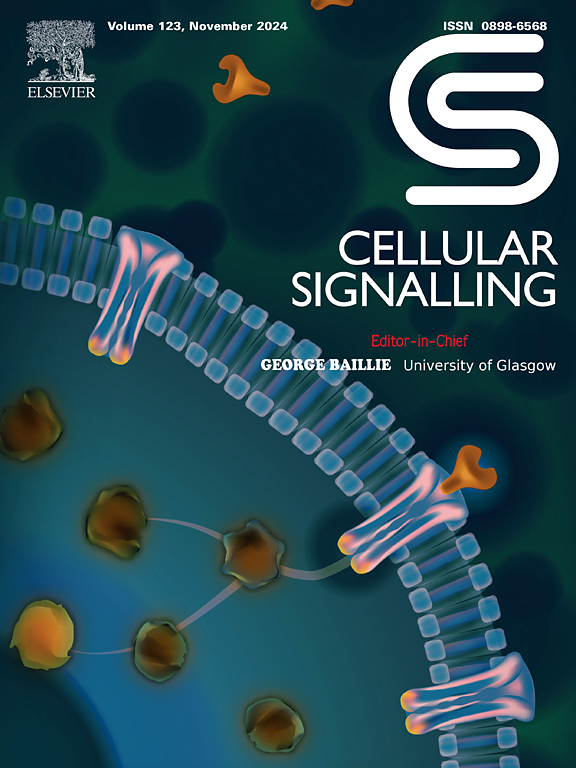桑辣素通过抑制AURKB-UCHL3相互作用诱导结直肠癌细胞自噬依赖性铁凋亡。
IF 4.4
2区 生物学
Q2 CELL BIOLOGY
引用次数: 0
摘要
背景:结直肠癌(Colorectal cancer, CRC)对人类健康构成重大威胁,其发生机制有待进一步探讨。桑辣素是一种天然类黄酮,具有抗结直肠癌的活性,但其分子机制尚不清楚。本研究旨在评价其抗结直肠癌的作用,阐明其分子机制,为结直肠癌的治疗提供新的思路。方法:分子对接预测桑苷与AURKB的潜在结合。实验验证包括qPCR, Western blotting,共免疫沉淀和免疫荧光。通过测定线粒体超氧化物、MDA、GSH和ROS水平以及NCOA4和FTH1表达来评估自噬依赖性铁下垂。结果:AURKB在结直肠癌中高表达,并通过与去泛素酶UCHL3相互作用来稳定,UCHL3激活PI3K/Akt/mTOR通路,抑制自噬依赖性铁凋亡。这种抑制的特征是线粒体超氧化物减少,MDA和ROS水平降低,GSH升高,FTH1上调。桑辣素破坏AURKB- uchl3相互作用,促进AURKB降解,逆转铁下沉抑制,抑制结直肠癌细胞增殖和迁移。结论:本研究首次证实桑里素通过靶向AURKB-UCHL3轴调控自噬依赖性铁上沉来抑制CRC进展,为其在CRC治疗中的治疗潜力提供了实验证据。本文章由计算机程序翻译,如有差异,请以英文原文为准。
Morin induces autophagy-dependent ferroptosis in colorectal cancer cells by inhibiting the AURKB-UCHL3 interactions
Background
Colorectal cancer (CRC) poses a significant threat to human health, and its underlying mechanisms require further exploration. Morin, a natural flavonoid, exhibits anti-CRC activity, but its molecular mechanisms remain unclear. This study aimed to evaluate its anti-CRC effects and elucidate its molecular mechanisms to provide new insights for CRC treatment.
Methods
Molecular docking predicted potential binding between morin and AURKB. Experimental validation included qPCR, Western blotting, co-immunoprecipitation, and immunofluorescence. Autophagy-dependent ferroptosis was assessed by measuring mitochondrial superoxide, MDA, GSH, and ROS levels, as well as NCOA4 and FTH1 expression.
Results
AURKB is highly expressed in CRC, and stabilized via interaction with the deubiquitinase UCHL3, which activated the PI3K/Akt/mTOR pathway and suppressed autophagy-dependent ferroptosis. This suppression was characterized by reduced mitochondrial superoxide, decreased MDA and ROS levels, elevated GSH, and upregulated FTH1. Morin disrupted the AURKB-UCHL3 interaction, promoted AURKB degradation, reversed ferroptosis inhibition, and suppressed CRC cell proliferation and migration.
Conclusion
This study is the first to demonstrate that morin inhibits CRC progression by targeting the AURKB-UCHL3 axis to regulate autophagy-dependent ferroptosis, providing experimental evidence for its therapeutic potential in CRC treatment.
求助全文
通过发布文献求助,成功后即可免费获取论文全文。
去求助
来源期刊

Cellular signalling
生物-细胞生物学
CiteScore
8.40
自引率
0.00%
发文量
250
审稿时长
27 days
期刊介绍:
Cellular Signalling publishes original research describing fundamental and clinical findings on the mechanisms, actions and structural components of cellular signalling systems in vitro and in vivo.
Cellular Signalling aims at full length research papers defining signalling systems ranging from microorganisms to cells, tissues and higher organisms.
 求助内容:
求助内容: 应助结果提醒方式:
应助结果提醒方式:


